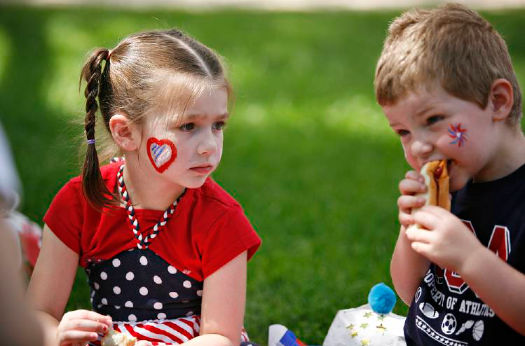How to Teach Kids About the Fourth of July
by Alexander Tidd
Ah, summer in America—the smell of sunscreen, backyard BBQs, and the sound of fireworks on repeat. The Fourth of July is iconic, but when it comes to explaining why we celebrate, kids often get a fireworks show without the history. So let’s make it more than marshmallows and sparklers. Let’s give them a snapshot of why a ragtag band of colonists decided to declare independence and why that still matters today.
From Tea and Taxes to Independence
Once upon a time, in a world without pizza delivery or Netflix, thirteen colonies were dealing with a lot of red tape from a king across the sea. They were upset, taxed without representation, stuck under laws they didn’t like, and generally feeling ignored. Calls of “no taxation without representation” echoed through town squares as colonists rallied around posters of angry kings and citizens.
That all led up to July 4, 1776, the day Congress approved the Declaration of Independence. It was a dramatic break not just from Britain but from the way things had been governed for centuries. A small group of founding figures wrote down some radical ideas: that all people are created equal and deserve life, liberty, and the chance to chase happiness. These were groundbreaking ideas, especially when monarchies ruled much of the world.
But let’s be honest: at the time of independence, the new nation was far from perfect. Women could not vote. Enslaved people were still considered property. Native Americans were not included in the vision, and many white men without land were excluded from participating in democracy. Those contradictions were present from the beginning, and they are worth talking about with our kids.
Celebrating What Worked, While Acknowledging What Needs Work
The Fourth of July gives us a chance to celebrate the ideas that helped shape this country. Our founding documents spoke of freedom and fairness in a way that inspired other nations. The United States challenged the status quo in a time when monarchs and empires held power without question. That spark led to revolutions in France, Latin America, and beyond.
But celebrating doesn’t mean ignoring the parts of our history that were deeply flawed. The people who signed the Declaration were visionary, scared, and imperfect. They wrote about liberty while excluding large parts of the population. They started something revolutionary while protecting systems of inequality.
As parents, we can teach both the victories and the efforts that followed. We can tell our kids that America was founded on bold ideas like free speech and democracy, but that it took a long and difficult fight to bring those rights to more people. We can help them see that progress has always required everyday people standing up and pushing for change.
This is not just a history lesson. It is also a lesson in critical thinking and hope. When kids understand that we can love a country while also wanting it to do better, they are learning the basics of being engaged citizens.
Making It Relevant Today
Let’s face it, politics today can feel overwhelming. Social media, non-stop headlines, and constant debates can make it hard to see the big picture. But the Fourth of July is a chance to take a breath and start meaningful conversations.
Your child might ask why people seem so divided, or what freedom means in today’s world. You don’t need to have perfect answers. Just be honest and open. Share what values matter most to you and what you hope your child will learn to stand for.
Ask questions like: What does fairness look like? How can we help others? Why is it important to vote? These conversations can happen around the grill, at the park, or while watching fireworks. They don’t need to be long or formal to be powerful.
This holiday is an invitation to think about what our country has done well and how it can do better. It is also a reminder that history isn’t over. We are living it right now, and our kids are going to help shape what comes next.
Making It Kid-Friendly
If you’re not sure how to start, try these simple ideas.
Read a version of the Declaration of Independence written for kids and talk about the main ideas. Create a homemade timeline that includes both the founding and key moments in the fight for civil rights. Invite your children to write their own declarations about what fairness means to them. Celebrate with fireworks, but also talk about what freedom and community mean.
The goal isn’t to teach every fact. It’s to plant the idea that freedom is not just a word. It is a responsibility, a promise, and a shared journey.
A Holiday That Holds More Meaning
Teaching kids about the Fourth of July isn’t just about patriotism. It’s about helping them understand where we come from and what kind of country we want to be. We can celebrate with joy while also being honest about the work that remains. We can be proud of our ideals and aware of our shortcomings at the same time.
When you talk to your kids this year, remind them that history belongs to all of us. They do not have to be future presidents or famous inventors to make a difference. They just have to care, ask questions, and try to leave the world a little better.
So go ahead—light the sparklers, flip the burgers, and watch the sky fill with color. But also take a few minutes to talk about freedom, fairness, and what it means to be part of a country that is still learning and growing.
The Fourth of July is more than a party. It’s a moment to reflect, to connect, and to raise the next generation of thoughtful Americans.
